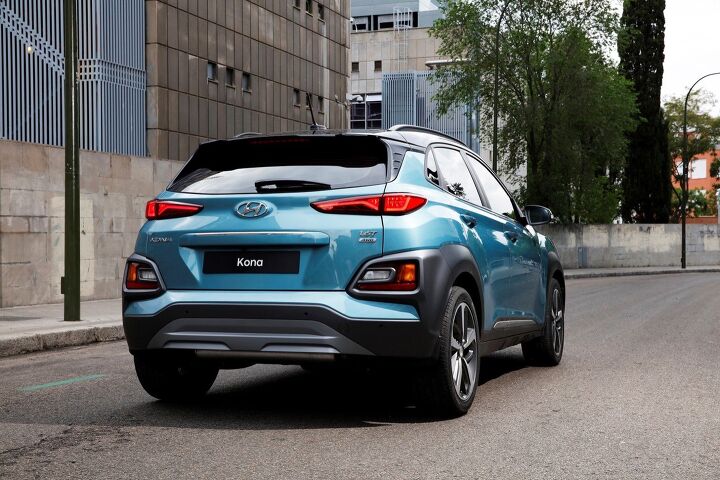Hyundai Releases Kona Pricing, Positions Subcompact Crossover As Value Leader

We’ll have to wait until Nissan releases pricing for its weirdly named Kicks before we can declare the 2018 Hyundai Kona the least-expensive subcompact crossover in America, but that’s the way it is for now.
The Korean automaker released its pricing list for the Kona on Wednesday, revealing a vehicle that undercuts every one its American and Japanese rivals in entry cost. Starting price for a Kona? $20,450 after delivery for a front-wheel-drive SE model.
That’s $195 cheaper than a base Honda HR-V, currently the best-selling subcompact crossover on the American market. The three-cylinder Ford EcoSport, which started sales in January, starts at $20,990 after delivery — a $540 difference. Compared to other competitors, the base Kona falls below the entry-level Mazda CX-3 by $635, the Chevrolet Trax by $1,545, and the Toyota C-HR by $3,045.
All of the crossovers listed are front-wheel-drive models powered by engines ranging from Ford’s 1.0-liter EcoBoost three-cylinder to the 2.0-liter units found in the Kona, C-HR, and CX-3.
The Kona’s Atkinson-cycle base engine, found on SE and SEL trims, makes 147 horsepower and 132 lb-ft of torque. A six-speed automatic is the engine’s only dance partner. Uplevel Limited and Ultimate trims gain a turbocharged 1.6-liter four-cylinder and seven-speed dual-clutch automatic, good for 175 hp and 195 lb-ft.
Adding all-wheel drive to a base SE brings the Kona’s after-delivery price to $21,750, just below that of a FWD Trax. (There’s incentives to be had on that model, though.) A better-equipped Kona SEL stickers for $22,100, or $23,400 is AWD is a must. If you can’t live with a vehicle unless its roof color contrasts with its body, throwing $150 at Hyundai nets you this feature on both SEL models.
Moving up the ladder, Limited models start at $25,650, with AWD variants rolling out the door for $26,950. Achieving the Ultimate means parting with $28,350, though going AWD adds another $1,300. This places the top-most Kona at just under the 30k mark— an important bar to stay below, considering the Kona’s place in the Hyundai food chain.
Shorter than a CX-3 and boasting 6.7 inches of ground clearance, the Kona arrives at U.S. dealers this spring. While the B-segment crossover market isn’t huge, Hyundai needs all the sales it can get. It also needs a presence in as many segments as possible.
After seeing a 14.3 percent drop in U.S. volume last year, Hyundai’s planning a crossover offensive over the next two years, with the Kona being the first out the gate.
[Image: Hyundai]

More by Steph Willems
Latest Car Reviews
Read moreLatest Product Reviews
Read moreRecent Comments
- El scotto UH, more parking and a building that was designed for CAT 5 cable at the new place?
- Ajla Maybe drag radials? 🤔
- FreedMike Apparently this car, which doesn't comply to U.S. regs, is in Nogales, Mexico. What could possibly go wrong with this transaction?
- El scotto Under NAFTA II or the USMCA basically the US and Canada do all the designing, planning, and high tech work and high skilled work. Mexico does all the medium-skilled work.Your favorite vehicle that has an Assembled in Mexico label may actually cross the border several times. High tech stuff is installed in the US, medium tech stuff gets done in Mexico, then the vehicle goes back across the border for more high tech stuff the back to Mexico for some nuts n bolts stuff.All of the vehicle manufacturers pass parts and vehicles between factories and countries. It's thought out, it's planned, it's coordinated and they all do it.Northern Mexico consists of a few big towns controlled by a few families. Those families already have deals with Texan and American companies that can truck their products back and forth over the border. The Chinese are the last to show up at the party. They're getting the worst land, the worst factories, and the worst employees. All the good stuff and people have been taken care of in the above paragraph.Lastly, the Chinese will have to make their parts in Mexico or the US or Canada. If not, they have to pay tariffs. High tariffs. It's all for one and one for all under the USMCA.Now evil El Scotto is thinking of the fusion of Chinese and Mexican cuisine and some darn good beer.
- FreedMike I care SO deeply!


































Comments
Join the conversation
I fail to see the value in this car when a base Forester is only 2k more and 18" longer. They get the same mpg.
Eagerly anticipating Sanjeev's Vellum Venom on this mess. (Mess being everything below the door-handle level)